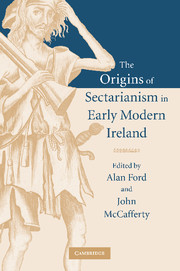Book contents
- Frontmatter
- Contents
- Preface
- List of contributors
- List of abbreviations
- 1 Living together, living apart: sectarianism in early modern Ireland
- 2 Confessionalisation in Ireland: periodisation and character, 1534–1649
- 3 Protestant prelates or godly pastors? The dilemma of the early Stuart episcopate
- 4 ‘In imitation of that holy patron of prelates the blessed St Charles’: episcopal activity in Ireland and the formation of a confessional identity, 1618–1653
- 5 A haven of popery: English Catholic migration to Ireland in the age of plantations
- 6 The Irish historical renaissance and the shaping of Protestant history
- 7 Religion, culture and the bardic elite in early modern Ireland
- 8 The political and religious thought of Florence Conry and Hugh McCaughwell
- 9 Sectarianism: division and dissent in Irish Catholicism
- 10 Purity of blood and purity of faith in early modern Ireland
- 11 Concluding reflection: confronting the violence of the Irish reformations
- Index
1 - Living together, living apart: sectarianism in early modern Ireland
Published online by Cambridge University Press: 24 November 2009
- Frontmatter
- Contents
- Preface
- List of contributors
- List of abbreviations
- 1 Living together, living apart: sectarianism in early modern Ireland
- 2 Confessionalisation in Ireland: periodisation and character, 1534–1649
- 3 Protestant prelates or godly pastors? The dilemma of the early Stuart episcopate
- 4 ‘In imitation of that holy patron of prelates the blessed St Charles’: episcopal activity in Ireland and the formation of a confessional identity, 1618–1653
- 5 A haven of popery: English Catholic migration to Ireland in the age of plantations
- 6 The Irish historical renaissance and the shaping of Protestant history
- 7 Religion, culture and the bardic elite in early modern Ireland
- 8 The political and religious thought of Florence Conry and Hugh McCaughwell
- 9 Sectarianism: division and dissent in Irish Catholicism
- 10 Purity of blood and purity of faith in early modern Ireland
- 11 Concluding reflection: confronting the violence of the Irish reformations
- Index
Summary
In 1615 Richard Stanihurst gave an account of the torture and death of the Catholic archbishop of Cashel, Dermot O'Hurley at the hands of his Protestant gaolers in 1584:
The officials put the archbishop's bare feet in boots which they filled with oil, tied his legs to the uprights of the stocks, and then lit a fire underneath. The boiling-hot oil worked its way up from his feet to his shins and other parts, torturing him unbearably, so that bits of skin fell away from the flesh, and pieces of flesh from the bare bones. The official in charge of the torture, unaccustomed to such bizarre mutilation, rushed suddenly from the room not wanting to continue looking at such monstrous barbarity, worse than that of wild beasts, nor to hear any longer in his fleeing ears the cries of the innocent archbishop which resounded in the vicinity. The Calvinist torturers feasted for a while on these extraordinary cruelties, but were clearly not satisfied. Accordingly after a few days they took the mangled archbishop early in the morning, almost dying from his continual torture … to a field not far away from Dublin Castle … and there hanged the innocent man from the gallows with a noose roughly made from brushwood…
In 1646 Sir William Temple described Catholic atrocities in the 1641 rising:
Others they buried alive, a manner of death they used to severall British in severall places: and at Clownis within the Countie of Fermanagh, there were seventeen persons, having been hanged till they were halfe dead, cast together into a pit, and being covered over with a little earth, lay pittifully, sending out the most lamentable groanes for a good time after.[…]
- Type
- Chapter
- Information
- The Origins of Sectarianism in Early Modern Ireland , pp. 1 - 23Publisher: Cambridge University PressPrint publication year: 2005
- 3
- Cited by



